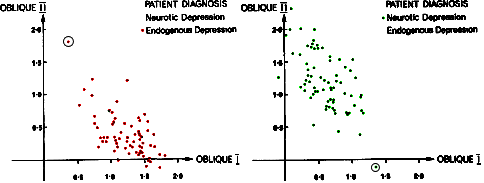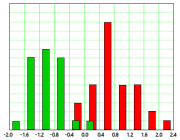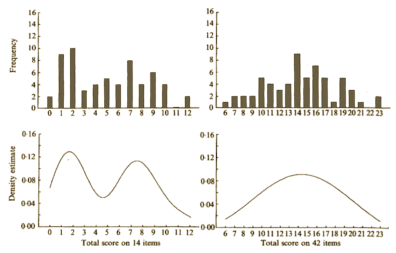Leslie Kiloh [1917-1997] was a British psychiatrist, well known for his studies in the classification of depressive disorders and the EEG. In 1962, he became the chair of psychiatry at the new Medical School at the University of New South Wales in Australia – a position he held for 20 years until retiring. He studied depressive cohorts in England and later Australia much as Lewis had done, but used more modern methods [multivariate factor analysis]. The internal workings of factor analysis are way beyond my skill set. Suffice it to say that they record many variables [~35] and the computers whirr all night. While the methodology is clearly too sophisticated to be "bloggable," the results look impressive to me [in multiple studies]. Here’s a representative picture of the kind of separations shown in his studies.

[colored and separated for clarity]
on review, the circled cases were misdiagnosed
"The analysis of data obtained in this study supports the view that ‘psychotic’ or endogenous depression is a condition with a restricted range of clinical manifestations, consistent with an imputed genetic or biochemical basis, whilst so-called neurotic depression is a diffuse entity encompassing some of the ways in which the patient utilizes his defence mechanisms to cope with his own neuroticism and concurrent environmental stress."
-
Kiloh, LG & Garside, RF. Depression: a multivariate study of Sir Aubrey Lewis’s data on melancholia.
Australian and New Zealand Journal of Psychiatry [1977]. 11:149-156.
 Again, the vicissitudes of multivariate factor analysis are well beyond capabilities of this mere mortal [namely me], but it identified two distinct clusters that had little overlap as shown in the graphic representation of their main results table from the reanalysis of Lewis’ data on the right. They had this to say about Aubrey Lewis’ papers:
Again, the vicissitudes of multivariate factor analysis are well beyond capabilities of this mere mortal [namely me], but it identified two distinct clusters that had little overlap as shown in the graphic representation of their main results table from the reanalysis of Lewis’ data on the right. They had this to say about Aubrey Lewis’ papers:"As a result of the clarity with which the two papers are written, few difficulties were experienced in the scoring, but inevitably an occasional decision was necessary."
"One must agree with Lewis that ordinary scrutiny of his data and the comparison of the clinical features with prognosis shows no discernible patterns and that he was correct, using the methods available at that time, in concluding that he could find no evidence of any qualitative distinction between “melancholia and mild neurasthenic depression” in his material. Nevertheless, more refined techniques now available show that this conclusion was incorrect, and in view of the tremendous influence that these papers have exerted, it is felt that this present analysis was worth carrying out."
"Thus, it may be concluded that, once again, a multivariate study has indicated that endogenous depression, though varying in severity, is a categorical condition. A patient either suffers from it or does not. Indeed, as has been pointed out by Kiloh et al. [1972], the dichotomy of depressive illness demonstrated in so many published studies is determined solely by the presence or absence of endogenous features. In other words, neurotic depression is defined by the absence of endogenous features, and this has given to this group of cases the illusion of being an entity. Both Paykel [1971] and Kiloh et al. [1972] have put forward evidence indicating that, when scrutinised by multivariate analysis, neurotic depression consists of a number of separable syndromes."
by GORDON PARKER and DUSAN HADZI-PAVLOVICPsychological Medicine. 1993 23:859-870.Sir Aubrey Lewis studied 61 depressives in considerable detail, principally cross-sectionally but also by reviewing progress. He concluded that he could find no qualitative distinctions between the depressed patients and thus established himself as a strong and influential advocate of the unitary view of depression [i.e. that depression varies dimensionally, not categorically]. Subsequently, Kiloh & Garside [proponents of the binary view of two depressive ‘types’] coded the Lewis data and undertook a principal components analysis. They claimed success in distinguishing ‘endogenous’ and ‘neurotic’ depressive types within Lewis’ sample. In this paper we re-analyse the data set using both a latent class categorical approach and mixture analyses. We suggest that any demonstration of sub-types was limited by relative homogeneity of the sample [in that up to 80% had probable or possible psychotic conditions], and by Lewis rating a number of important features [e.g. delusions] dimensionally rather than categorically. Nevertheless, we identify one categorical class [essentially an agitated psychotic depressive condition] and a residual [presumably heterogeneous] class. The presence of those two classes was supported by demonstrating bimodality in composite scores derived from the fourteen differentiating clinical features [and not evident when all clinical features were considered], and formally confirmed by mixture analyses. Membership of the categorical class was determined principally by psychotic features [delusions and hallucinations] and by objectively-judged psychomotor disturbance, and we consider the nature of that ‘class’. Lewis’ data set is unusual [in having self-report and observationally rated data], and historically important in demonstrating that conclusions may depend on the choice of variables examined and analytical approaches.
"Leslie Kiloh scored all of Lewis’ subjects on depressive symptoms and analysed the data to show separation. We then used latent class analysis … to analyse the Kiloh-rated data set evaluating Kendell’s argument that a unimodal distribution would argue for depression differing only by severity and that a bimodal distribution would be required to support the division of melancholic and non-melancholic depression. When we included all of Aubrey Lewis’ items there was a unimodal distribution. When we limited analyses to central markers of melancholia [essentially psychomotor disturbance] there was a distinct bimodal one – and we made the point that including non-differentiating items [ie DSM MDE in the main, and most endogeneity symptom lists] in any analysis can ‘swamp’ the true capacity of the contrasting depressive groups to differentiate. I’m preparing a paper at the moment where we analyse data using the SMPI [Sydney Melancholia Prototype Index] and again we demonstrate distinctive bimodality. I hope this assists."

What’s the measurement tool(s) on the X Axis?
I’d like to see that study with DEP and the three subsets of DEP on the PAI instead of the usual HamD or whatever.
https://quizlet.com/24448398/pai-clinical-scales-and-subscales-flash-cards/